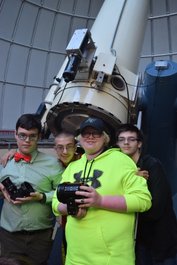User-Centered Universal Design of Accessible Tools for Astronomy
The IDATA project will engage students and teachers who are blind and visually impaired (BVI) or sighted to design, develop, and test software and learning modules that improve accessibility of astronomy tools for educational and professional uses. The project team will utilize user-centered design/universal designing (UCD/UD) processes and the iterative method for the development and testing of software and modules.
The research will advance knowledge about learning related to: 1) computational thinking; 2) the role of computation in astronomy and software design; and 3) how participation influences students’ attitudes and beliefs about who can engage in science, technology, engineering, and mathematics (STEM) and computing. The accessible software and instructional modules produced in this study may be adopted by a range of BVI and sighted individuals, but may also be transferrable to other similarly visually-intensive domains such as satellite, geophysical, and medical imaging.
The research will advance knowledge about learning related to: 1) computational thinking; 2) the role of computation in astronomy and software design; and 3) how participation influences students’ attitudes and beliefs about who can engage in science, technology, engineering, and mathematics (STEM) and computing. The accessible software and instructional modules produced in this study may be adopted by a range of BVI and sighted individuals, but may also be transferrable to other similarly visually-intensive domains such as satellite, geophysical, and medical imaging.
IDATA PARTICIAPANTS
All IDATA students and teachers will be part of a design process that puts the user at the heart of the action. All participants will have the opportunity to: 1) learn about issues related to accessibility for persons with visual impairments, 2) learn about the data processing needs of astronomy professionals, and 3) work as part of a team to consider new ways of exploring and analyzing astronomical data. Two groups of teachers and students will work with professionals to co-develop astronomical data analysis software that is accessible to those with BVI disabilities. Eligible teachers include teachers of the visually impaired (TVI), special education teachers who work with BVI students, or astronomy, space science, physics, computer science, or technology educators working with students at the high school level. Two different groups of teachers and students will contribute to the software design process: Tier 1 and Tier 2
IDATA Activites
Both Tier 1 and Tier 2 participants will be part of a variety of astronomy, software design and computer science experiences. Examples may include:
Both Tier 1 and Tier 2 participants will be part of a variety of astronomy, software design and computer science experiences. Examples may include:
- Complete data requests from the Skynet Robotic Telescope Network
- Control a Skynet Telescope using the Quorum programming lanuage
- Detect an asteroid in a series of data arrays
- Participate in web chats with IDATA staff, software engineers and design experts
- Research a visual disability and designing goggles that will simulate the condition
- Learn how a screen reader works and how its use impacts design decisions
- Complete an astronomy or computing science related task using a vision disability simulator
- Interview astronomers about how they use astronomical data and the tools they need to complete those tasks
- Design and conduct a focus group or scientific survey to test new software features

